7 Strategic Ways to Implement Automation in Retail for Maximum Efficiency
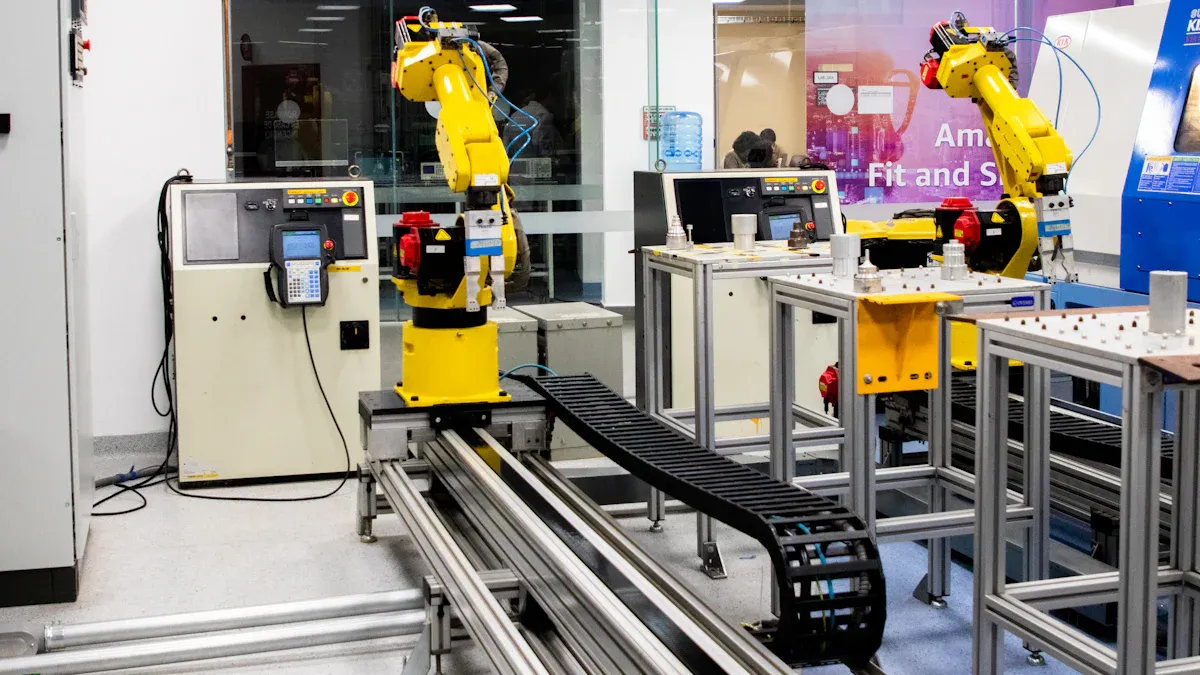
Have you ever wondered how top retailers stay efficient while cutting costs? When you implement automation, you unlock real benefits that make your store run smoother. Take a look at the numbers:
Metric | |
|---|---|
Cost Savings | Demonstrates tangible benefits beyond efficiency gains. |
Workforce Productivity | Frees staff from repetitive tasks, allowing focus on customer-centric activities. |
Operational Efficiency | Streamlines processes, minimizes bottlenecks, and enhances resilience during peak times. |
You will see practical steps and real-world examples that help you use these advantages in your own business.
Key Takeaways
Implement automation in inventory management to reduce stockouts and improve customer satisfaction. Use AI to predict demand and automate reordering.
Adopt self-service solutions like checkout kiosks to speed up transactions and enhance customer experience. This allows staff to focus on assisting customers.
Utilize automated marketing campaigns to boost engagement and sales. Personalize messages based on customer behavior for better results.
Leverage data-driven tools like sales dashboards and automated reports to make informed decisions. This helps you respond quickly to market changes.
Enhance workforce productivity with automated scheduling tools. Match staffing levels to demand, ensuring optimal service during busy times.
Implement Automation for Inventory
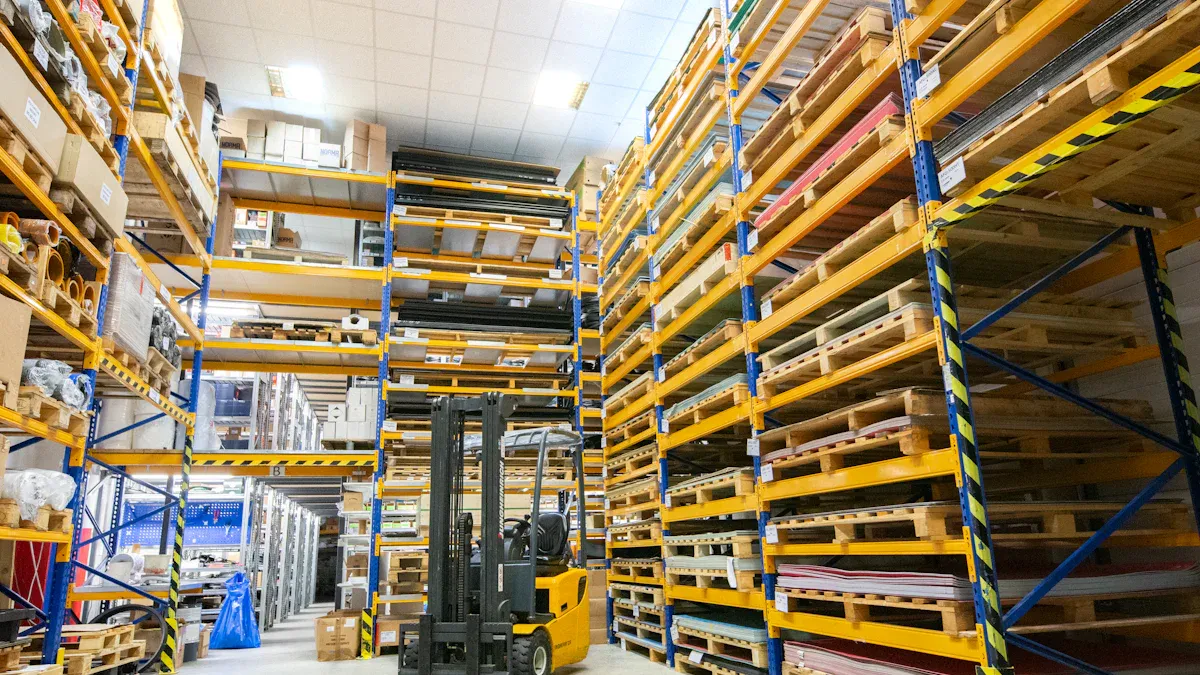
Stock Replenishment
You can implement automation in your inventory by using advanced software and order management systems (OMS). These tools help you track stock levels and automate the process of reordering products. When you use automation, you reduce the risk of running out of popular items. You also save time because the system handles repetitive tasks for you.
Strategy | Description |
|---|---|
OMS | Streamlines inventory management by providing real-time visibility and automating critical processes. |
Advanced Software | Offers real-time visibility into inventory levels and automates reorder processes. |
Automation Technologies | Includes AS/RS to streamline inventory handling and reduce labor costs. |
Analyzes historical data to predict demand and optimize stock levels. |
When you automate stock replenishment, you see real results. Retailers have reported a 35% drop in fulfillment errors and up to 28% lower costs. You can also improve on-time delivery by 11% and boost revenue by 19%. These numbers show how automation makes your store more efficient and cost-effective.
Real-Time Tracking
Real-time tracking gives you a clear view of your inventory at all times. Automated systems update stock levels instantly, so you always know what you have on hand. This helps you avoid mistakes and keeps your records accurate.
Automated inventory systems capture data continuously. This means you’re no longer working with outdated figures or second-guessing stock levels. Real-time visibility allows you to identify discrepancies instantly and take corrective action before they snowball.
When you implement automation for real-time tracking, you reduce manual errors and make better decisions. You can spot problems early and fix them before they grow.
Reduce Stockouts
Stockouts frustrate customers and hurt sales. You can prevent this by using AI and machine learning to predict demand and automate reordering. These tools help you keep shelves stocked and customers happy.
AI-driven demand forecasting leads to a 20–50% reduction in forecasting errors.
Results in 65% fewer stockouts, ensuring product availability.
Automatically reorders items when stocks are low, enhancing customer satisfaction.
When you implement automation, you keep your inventory lean and avoid overstocking. This saves money and improves your store’s performance.
Self-Service Solutions
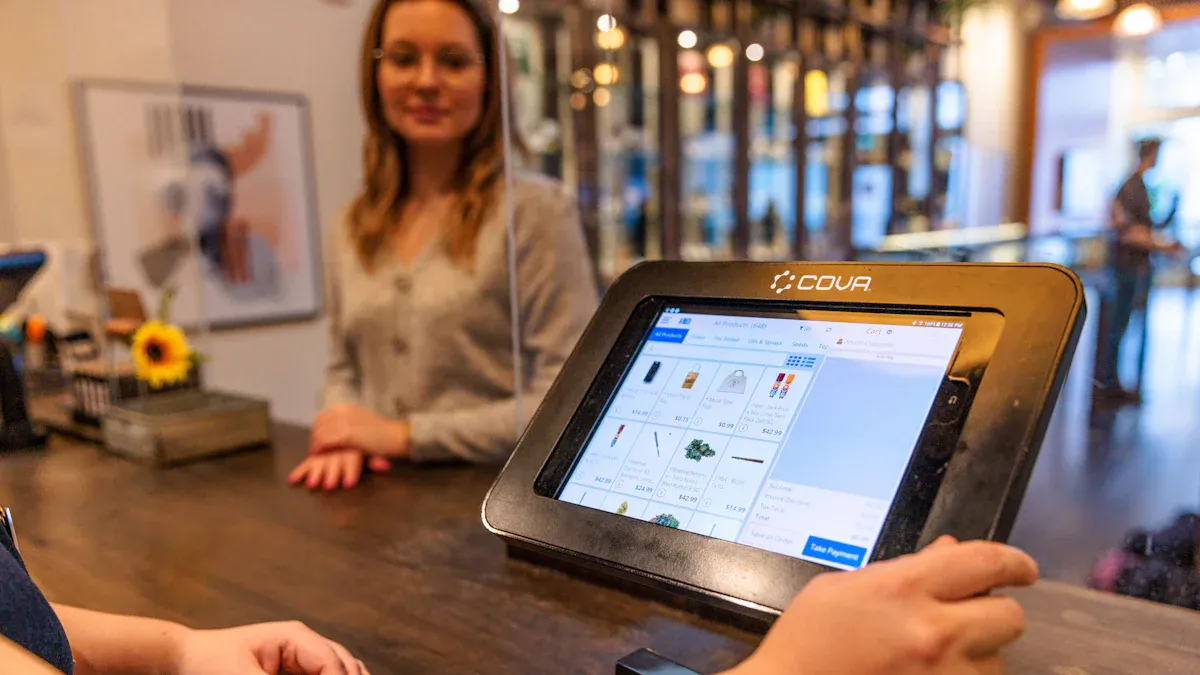
Checkout Kiosks
Checkout kiosks change how you serve your customers. These machines let shoppers scan items, pay, and get receipts without waiting in long lines. You help customers move faster through the store, especially during busy times. When you use self-checkout, you can assign staff to other important tasks, like helping customers find products or answering questions.
Self-service kiosks let customers place orders, pay, and get receipts on their own.
You can speed up transactions by up to 30% with self-checkout technology.
One employee can help several customers at once, which makes your team more efficient.
You reduce mistakes at checkout and lower the pressure on staffed counters.
Tip: Checkout kiosks work best in high-traffic stores where lines often form.
You see real gains in efficiency and accuracy. The table below shows the impact:
Metric | Impact |
|---|---|
Efficiency Improvement | Measurable |
Accuracy Improvement | Measurable |
Operational Cost Reduction | Significant |
Mobile Payments
Mobile payments make shopping easier for your customers. Many people trust mobile payment apps and use them every day. When you offer this option, you show that your store values speed and convenience. Security matters to shoppers, so you should choose trusted providers and keep their data safe.
"The bottom line is that mobile payments are not going away. In the next few years we may see differences in how we transact, but we will keep our mobile device as the payment initiator."
Customers like mobile payments because they are fast and simple. You can encourage more people to use them by making the process easy and secure.
Simplify the user experience
Provide incentives for using mobile payments
Partner with trusted providers
Educate shoppers about the benefits
Enhance Experience
When you implement automation, you create a better shopping experience. Many top retailers use technology to help customers find what they need and feel confident in their choices.
Amazon suggests products based on what you have bought or browsed before.
Stitch Fix uses algorithms to recommend clothes that match your style.
IKEA offers a virtual assistant to help you see how furniture looks in your home.
Lowe's uses a robot to answer questions and guide you in the store.
You can see the results in customer satisfaction and loyalty:
Metric | Impact |
|---|---|
35% | |
Customer Loyalty Increase | 19% greater |
Customer Satisfaction Rate | 23% higher |
Over 62% of shoppers prefer AI chatbots for quick answers. Retailers who use these tools see more repeat customers and higher sales. You make shopping easier and more enjoyable for everyone.
Automate Supply Chain
Order Processing
You can make your supply chain faster and more reliable when you automate order processing. Automated systems sort products, approve orders, and send shipments with less human error. You see orders move quickly from your store to your customer. This speed helps you keep up with demand and avoid delays.
Key Point | Description |
|---|---|
Faster Processing Times | Orders get fulfilled quickly with fewer mistakes. AI helps sort, ship, and deliver products. |
Automated Order Processing | You spend less time on approvals and paperwork. Automation removes bottlenecks and errors. |
When you use automated order management, you free up your team to focus on helping customers. You also collect data easily for audits and reports.
Demand Forecasting
You can predict what your customers want by using automated demand forecasting. Smart systems look at past sales and trends to help you order the right amount of stock. This keeps your shelves full and avoids waste.
You save over 7% on yearly operating costs with accurate forecasting.
Better forecasting means fewer stockouts and less extra inventory.
New tools help you set safety stock levels based on reliability and seasonality.
When you use these tools, you optimize your supply chain and improve customer satisfaction. You also reduce errors and make better decisions.
Lower Costs
You lower your supply chain costs when you implement automation. Robotic Process Automation (RPA) helps you cut costs by up to 40%. Some companies save between 30% and 70% after switching to RPA. Retailers could save about $340 billion every year with these changes.
Automation reduces labor costs by handling routine tasks.
You improve product availability and reduce mistakes.
Real-time analytics help you spot problems early and avoid waste.
Walmart uses automation to manage over 100,000 suppliers. This shows how important it is to choose ethical and sustainable partners. Automation gives you better visibility, so you can fix issues before they grow.
Tip: Automation helps you meet customer needs and avoid fines for late deliveries.
Personalized Marketing
AI Segmentation
You can use AI segmentation to understand your customers better. AI tools sort shoppers into groups based on their interests and buying habits. This helps you send messages that match what each person likes. For example, a fashion retailer used AI to find style preferences. The result was a 35% increase in sales from personalized emails. A tech company targeted customers ready to upgrade, which led to a 20% boost in upsell rates.
AI finds patterns in customer data.
You can target shoppers with offers they want.
Sales and upsell rates go up when you use smart segmentation.
Tip: AI segmentation helps you reach the right people at the right time.
Automated Campaigns
Automated campaigns save you time and improve results. You set up emails, texts, or ads that go out based on customer actions. These campaigns run day and night, so you never miss a chance to connect. You see higher open rates and more clicks when you use automation.
Metric | Value |
|---|---|
B2B marketers using automation | 67% |
Improved customer retention | 58% |
Higher customer satisfaction | 51% |
Revenue from automated emails | 320% more |
Higher open rate | 15.2% |
Higher click-through rate | 34% |
Consumers engaging with personalized content | 82% |
Positive ROI in first year | 76% |
Increase in qualified leads | 451% |
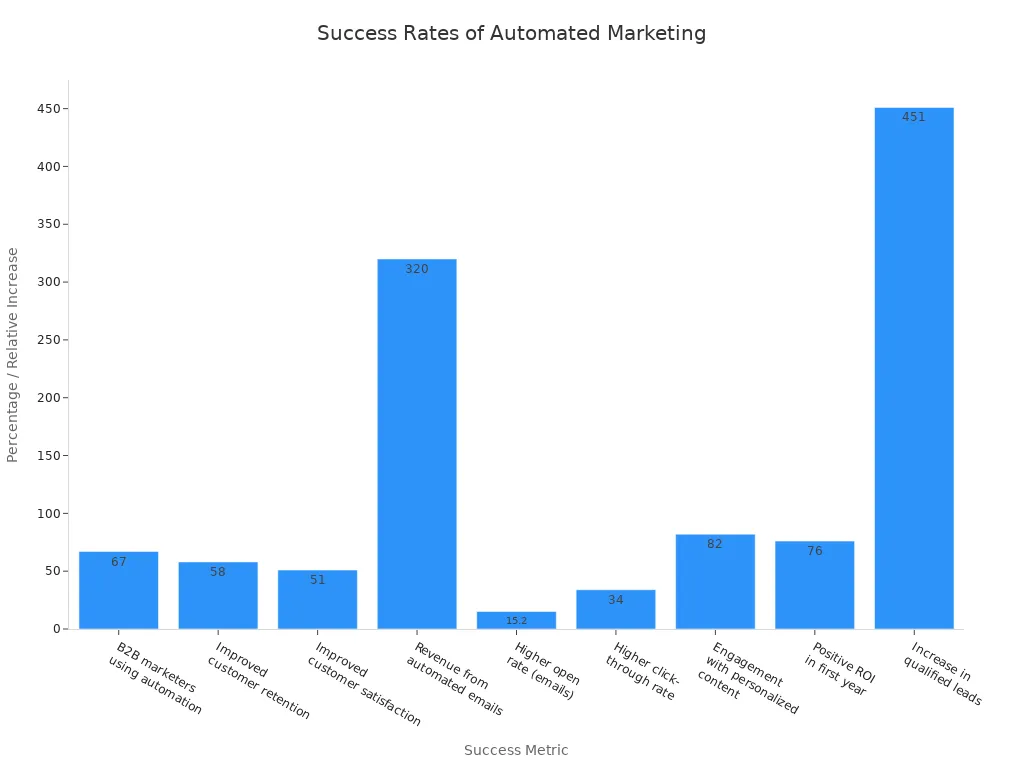
You can implement automation to make your marketing smarter and more effective.
Boost Engagement
You boost engagement by sending messages that matter to each shopper. Automation lets you personalize messages based on what customers do. You can remind someone about a forgotten cart or send a welcome note to new subscribers. Tailored post-purchase emails get more replies than standard messages.
Personalized messaging increases relevance.
Cart abandonment messages match each shopper’s history.
Welcome emails lead to more purchases.
Post-purchase emails drive higher interaction.
Metric | Outcome |
|---|---|
Customer Retention | Increase by 15% |
Average Order Value (AOV) | Improve by 10% |
Repeat Purchases | Boost within six months |
Conversion Rates | From campaigns |
Customer Lifetime Value (LTV) | Measured over time |
Return on Ad Spend (ROAS) | Performance indicator |
Loyalty Program Participation | Points redemption rates |
You see more loyal customers and higher sales when you use automation to boost engagement.
Workforce Productivity
Scheduling Tools
You can boost your team’s productivity by using automated scheduling tools. These tools predict staffing needs and match schedules to busy times in your store. When you use automated scheduling, you avoid overstaffing and prevent understaffing during peak hours. This means you always have the right number of employees on the floor.
Benefit | Description |
|---|---|
Labor Cost Optimization | Reduces overstaffing and prevents understaffing during peak periods by matching staffing levels to demand. |
Enhanced Customer Experience | Ensures adequate service coverage during busy times, leading to improved customer satisfaction and sales. |
Increased Employee Satisfaction | Provides schedule flexibility and preference matching, reducing turnover and improving staff engagement. |
Compliance Management | Automates enforcement of labor laws and company policies, minimizing legal risks. |
Data-Driven Decision Making | Offers insights for continuous improvement in staffing strategies through advanced analytics. |
Financial Impact | Retailers see a 3-5% reduction in labor costs and improved sales metrics with optimal staffing. |
Automated scheduling tools help you make better decisions and keep your team happy. You can also use these tools to follow labor laws and company rules.
Task Automation
When you automate repetitive tasks, you give your employees more time for important work. Automated systems can handle things like order management, inventory checks, and answering common questions. Your team can then focus on helping customers and solving problems.
Task automation makes your business run smoother. Employees feel more satisfied because they spend less time on boring tasks and more time on meaningful work. This leads to better customer service and higher sales. You may need to train your team for new roles, but most employees welcome the chance to learn new skills.
Tip: Use automation to assign tasks based on each employee’s strengths and availability. This helps everyone work at their best.
Reduce Labor Costs
You can reduce labor costs when you implement automation in your store. Automated tools predict busy hours and help you schedule the right number of staff. Self-checkouts and inventory scanning systems also lower the need for extra workers.
Automation in retail has led to a 20% drop in front-line labor costs.
Retailers use technology to minimize human oversight and save money.
Automated systems need less training, which cuts long-term costs.
AI-driven scheduling keeps staffing levels just right, so you avoid paying for extra hours.
Automated employee support tools also help your team solve problems faster, making your store more efficient.
Data-Driven Decisions
Sales Dashboards
You can use sales dashboards to see your store’s performance in real time. These dashboards show important numbers like sales, inventory, and customer trends. You get a clear picture of what is happening in your business every day. Dashboards help you spot problems early and act fast.
Advantage | Description |
|---|---|
Real-time data access | You see up-to-date sales and inventory numbers, so you can react quickly to changes. |
Centralized data view | Dashboards put all your key numbers in one place, making it easy to track trends and spot issues. |
User-friendly interface | Simple designs help you understand the data without confusion, so you make better decisions. |
You can customize dashboards to track the numbers that matter most to your store.
Dashboards help you focus on your goals by showing only the most important information.
By using dashboards, you make smarter choices and keep your store running smoothly.
Automated Reports
Automated reports save you time and give you accurate information. You do not have to spend hours collecting data or worry about mistakes. Automated systems gather data from different sources and create reports for you.
Real-time data access lets you respond quickly to changes in the market.
Automated reports reduce human error, so your numbers are more accurate.
You save time and money because the system does the work for you.
You can use these reports to check sales, track inventory, and plan for busy times. Automated reports help you stay ahead of problems and make better plans for your store.
Informed Choices
You make better decisions when you use data from all parts of your business. Automation brings together information from your sales, inventory, and customer systems. AI tools look at this data to find trends and warn you about possible problems.
Automation connects your sales, inventory, and customer data.
AI finds patterns and predicts what might happen next.
You can act quickly and fix issues before they grow.
Evidence Type | Description |
|---|---|
Inventory Management | Prevents overstocking or stockouts, saving money and improving service. |
Personalized Marketing Strategies | Targets campaigns to customer preferences, boosting sales and loyalty. |
Supply Chain Visibility | Reduces disruptions and improves resilience. |
Customer Experience Enhancement | Tailors offerings to increase loyalty and repeat purchases. |
Predictive Analytics for Demand Forecasting | Helps you order the right amount of stock and avoid waste. |
Continuous Improvement | Lets you adjust your strategies as you learn from new data. |
When you use automation for data-driven decisions, you make your store more profitable and ready for the future.
Risk Mitigation
Retail stores face many risks every day. Automation helps you spot problems early and protect your business. You can use smart technology to keep your store safe, follow rules, and avoid costly mistakes.
Smart Surveillance
You need strong security to stop theft and fraud. Retailers lose over $100 billion each year because of these crimes. Organized retail crime cost U.S. stores over $112 billion in 2023. Smart surveillance systems use AI to watch for trouble and alert you right away.
Description | |
|---|---|
Theft and Fraud | Shoplifting, employee theft, and return fraud cause big losses. |
Inventory Damage | Poor handling or accidents can ruin products. |
Safety Hazards | Slips and falls put staff and customers at risk. |
Supply Chain Disruptions | Problems in supply chains lead to empty shelves and lost sales. |
Data Breaches and Cybersecurity Risks | Phishing and malware threaten customer data. |
Noncompliance and Legal Risks | Breaking laws can bring heavy fines. |
Reputational Risk | Bad publicity hurts trust and loyalty. |
Omnichannel-Specific Risks | Hard to keep inventory and customer experience smooth across channels. |
People Risk | High turnover and misconduct disrupt operations. |
Stores like Walmart use AI-powered cameras at checkout to catch missed scans. Amazon Go uses sensors to prevent shoplifting. Home Depot uses facial recognition to fight organized crime. You can rely on these tools to watch your store and keep it safe.
AI video analytics spot suspicious actions.
Real-time monitoring lets you respond fast.
Automated alerts notify your team about problems.
Efficient footage review saves time.
Less labor needed for security.
Quick access to video helps solve incidents.
Automated Alerts
Automated alerts help you act quickly when something goes wrong. These systems send notifications if they spot theft, errors, or safety issues. You can stop problems before they get worse.
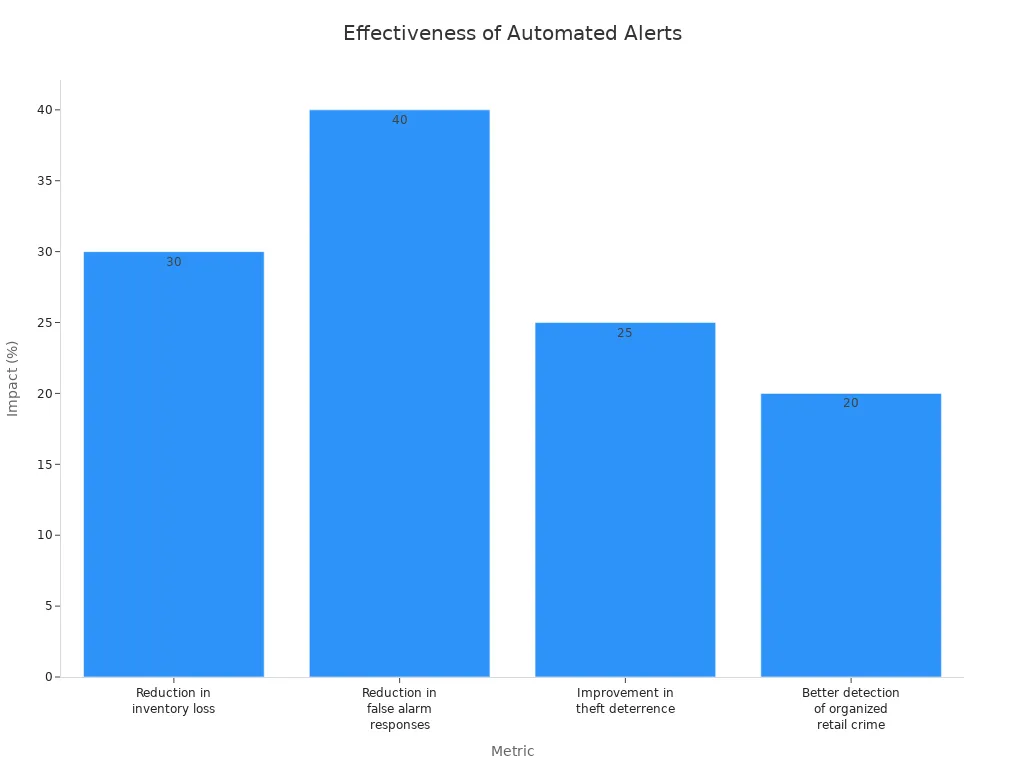
Metric | Impact |
|---|---|
Reduction in inventory loss | |
Reduction in false alarm responses | 40% |
Improvement in theft deterrence | 25% |
Better detection of organized retail crime | 20% |
You see fewer losses and better security. Automated alerts also cut down on false alarms, so your team can focus on real threats.
Improve Compliance
Automation helps you follow laws and company rules. You can track risks, run checks, and keep records up to date. This makes your store safer and avoids legal trouble.
Benefit | Description |
|---|---|
Centralized and Organized Risk Tracking | You keep all risk data in one place, making it easy to find and use. |
Streamlined Risk Assessments | Automated checks use the same methods every time, reducing mistakes. |
Real-time Visibility and Insights | Dashboards show up-to-date risk information, helping you make smart choices. |
You improve accuracy and save time.
Automation gathers important risk data for you.
The system suggests ways to lower risks and tracks them over time.
Stores that use automation for risk management see better compliance and stronger protection against problems. You build a safer, more reliable business when you use these tools.
Automation transforms your retail business. You gain efficiency, boost profits, and scale with less effort. Review your current processes. Find the automation strategies that fit your needs best.
Take the first step today. Try one automation tool and see the results. Share your experience in the comments. Your story can inspire others to start their own journey.
FAQ
What is retail automation?
Retail automation uses technology to handle tasks like inventory, checkout, and marketing. You can use software, robots, or AI tools. These systems help you save time, reduce mistakes, and improve your store’s performance.
How much does it cost to automate a retail store?
Costs vary based on your needs. Small stores may spend a few thousand dollars. Large retailers may invest much more. You can start with simple tools and add more as your business grows.
Tip: Begin with one area, like inventory or checkout, to manage costs.
Will automation replace retail jobs?
Automation changes some jobs, but it does not remove the need for people. You can use automation to handle repetitive tasks. Your team can then focus on helping customers and solving problems.
Task Type | Who Handles It |
|---|---|
Repetitive | Automation |
Customer Service | Your Employees |
How do I choose the right automation tools?
First, look at your store’s biggest challenges. Next, research tools that solve those problems. Ask for demos and read reviews. Choose solutions that fit your budget and work with your current systems.
Note: Start small and scale up as you see results.
See Also
Modern Retail Benefits From AI-Enhanced Vending Machines
Smart Technology Is Transforming Electronics Vending Machines Today
Transforming Online Store Management With AI E-Commerce Tools
The Future of Fast Food Lies in Vending Machines
Walgreens Self-Checkout: Balancing Convenience With Retail Challenges
